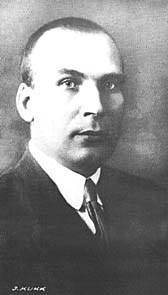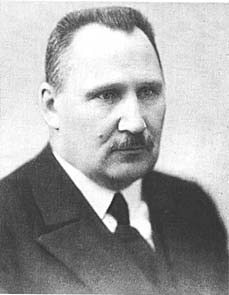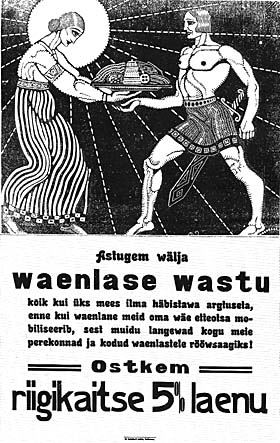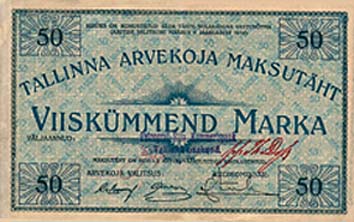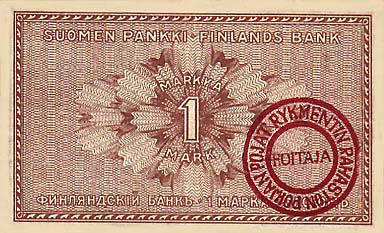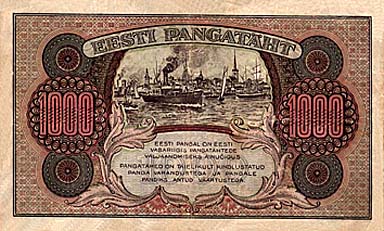|
|
||||||
|
|
||||||
|
by Juri Rudich
& Ants Kulo
Part I: Period 1918-1928 Although the Republic of Estonia had already been proclaimed on February 24, 1918 under the conditions of German occupation any kind of public activity to establish independent statehood was inconceivable. The opportunity to do that came only after the surrender of Germany to the victorious states of World War I on November 1st 1918. On the same day the Estonian Provisional Government reassembled, and besides other vital questions, a lot of attention was paid to developing our own financial system. In order to set about arranging the political life of the country as fast as possible, on the 19th of February the Provisional Government passed the «Provisional Administrative Laws», which revalidated the old laws in force until October 24th, 1917, and the ones passed by the German military authorities in Estonia and Livonia. The decree of the occupation government from September 15th, 1918 was left to regulate finance and that validated the mark standard in Estonia. Besides the German state and Ostmarks also different kinds of Russian rubles were in circulation in Estonia at that time. To facilitate the circulation of currency at the time, when so many different kinds of currencies were in use, on November 18th, 1918 the Provisional Government decided to establish a fixed exchange rate for them. According to the regulation of Minister of Finance, referring to the ruling from the time of occupation, from December 3rd the East ruble was rated the highest, equaling 2 marks. A Czar’s ruble came to cost one mark 50 pennies, a «Duma’s» ruble one mark and 25 pennies, and a «Kerenski» ruble one mark.
At that time important events took place on the Eastern border of
Estonia. On November 29th the Red Army troops occupied Narva,
where on the same day a socialist republic was proclaimed under the name
of the Working people's Commune. Already on December 2nd,
1918 a decree for arranging financial matters was issued. With this
document the ruble in circulation in the Russian SFSR was established as
the legal tender on the territory under the Soviet power, while the
Czar’s, Duma’s and «Kerenski» ruble were rated equal.
So the same banknotes were in circulation in both parts of
Estonia, but within the framework of two completely different financial
systems. The influence of the above-mentioned decree, however, lasted
for a short term, because by the middle of 1919 Estonia had been freed
from intruders. The national reconstruction work and the War of Independence that required unprecedented expenses from the young state. To mitigate a major shortage of money, several European countries were approached for a loan. Help, however, was given by Finland only, from where at the beginning of December in 1918,10 million marks were conveyed to Estonia. On December 14th, 1918 the Provisional Government issued a ruling, according to which the Finnish mark was proclaimed to be the legal tender within the borders of the Republic of Estonia. As for its exchange rate it was to be equal to the Ostmark or 50 kopecks.
Advertisements poster for issue of Republic
Debt Obligation Notes. Author: Eduard Wiiralt. Concurrently
with seeking loans from abroad, activities for obtaining money went on
also in Estonia. Since the population had abundantly diverse bills, the
Government made a proposal to start issuing 5 per cent state fidelity
notes, e.e., to arrange a domestic loan. In principle the National
Council approved of the project on November 23rd. Its
decision established 30 million marks as the subtotal of the planned
emission and appointed the dates of redemption as May 1st,
June 1st, and July 1st of 1919. The Provisional
Government was given the right to permit the Ministry of Finance, in
case of necessity, to issue additional state fidelity notes for 20
million marks in series with a term and interest rate fixed by the
Government. At the same time the subscription of notes advanced fairly
slowly in spite of active propaganda. Even establishing an obligation to
subscribe for the counties did not help. By the 16th of
January 1919 on account of the fidelity notes only 8,9 million marks had
come in for the state, that is approximately 30 per cent of the planned
subtotal. Mention should also be made of the fact that the Red Army
temporarily occupied a large part of Estonia at that time. To prevent a
total failure of the domestic loan, the Government had no other choice
but to proclaim the notes legal tender with its regulation of January 16th.
On January 30th a specifying announcement of the Minister of
Finance was issued which claimed that the official currency would be 50
to 100 mark notes. However, the 5000 to 10,000 bills remained promissory
notes as before.
The 5 per cent state fidelity notes were not the only liabilities
of the Republic of Estonia that found use as a substitute for money. On
January 19th, 1920 the Government passed a bill, which gave
the Minister of Finance, in order to supplement the sum in the Treasury,
the right to issue short term treasury bills, the subtotal, redemption
date and interest rate of which ere to be fixed by the Government. The
treasury bills ere to have the signatures of the Minister of Finance,
the Treasurer, and the Director of the State Accounting Department. The
state took the responsibility for them. So the Government decided to increase the domestic loan by 250 million marks. Although the bills were meant to improve the financial situation of the state in the first place, the population started to use them as protective means of payment. However,
by 1922 as sufficient amount of 1000 mark treasury notes had come into
circulation. However, the
short-term 5 per cent state fidelity notes were not the first own legal
tender of the independent Estonia. Already a couple of weeks before them
the receipts of payment of the Tallinn Clearing House came into
circulation as a currency. A Clearing House is a place where transactions can be settled through inter-bank transfers. This kind of a procedure saves, firstly, a large amount of cash and secondly, notably speeds up and simplifies management. The initiative in founding the Clearing House was taken by Tallinn's credit banks at the end of the year 1918. The Clearing House founded to the Harju Bank with consent of the Ministry of Finance issued checks of different value for more than 150.000 marks already in December 1918. Naturally, the checks were used only to conduct their own dealings. To mitigate the severe shortage of banknotes, in January 1919 the Provisional Government passed a bill according to which «... notes issued besides the Ostmarks approved by the Tallinn Clearing House were to be granted the character of legal tender». In January 1919 banknotes were substituted for by the Clearing House checks, but at the end of February the first 20,000 marks of notes specially printed as currency came into circulation. They were emitted in two face values: the A series 100 mark notes and the B series 50 mark notes. The rest of this issue denominations and series, which are mentioned by several catalogues, are unfortunately the result of their authors' imagination, which is probably based on the law published in «Riigi Teataja» and on the fact that the 100 and 50 mark notes belong to different series.
Face side of #A2b – 50(Ost) Marka 1919. The
uncontrolled amount of bills issued by former governments with the
additional bonds of different kinds and foreign notes was not enough to
satisfy the need for currency of the young independent state. Therefore,
Estonia started making preparations for the printing of its own «real»
money simultaneously with issuing the above-mentioned notes.
Already at a meeting of the Provisional Government on November 30th,
1918 the decision to establish the Estonian mark as the state standard
was made. Founding a bank took a while, but since there was the
Treasury, the Government decided to start issuing money as treasury
notes to begin with. The next legislative step towards our own currency
was the regulation by the Provisional Government from December 9th,
1918, which granted the Minister of Finance the right to put the
treasury notes into circulation. The notes were to be printed in 5,10,
20, and 50 penni and 1, 3, 5,10, 20, 50, 100, and 500 mark bills, while
the amount of emission was to be fixed by the Provisional Government.
The exchange rate of the Estonian mark was to equal 1 Ostmark or 1
German mark or 50 kopecks. The choice of a mark as the denomination was not incidental. As an explanation, the Finnish standard has in this case usually been indicated in connection with the circulation of the Finnish Markka during the first month of the Republic of Estonia. But the Finnish Markka became the legal tender of Estonia only on December 14th, that is two weeks after the Government’s decision. As mentioned above, at that time Estonian finance was based on the laws of German occupational government, Which established the mark standard here. In its decision the Provisional Government could not and did not want to contradict this. The idea was to issue our own currency according to the established, i.e., the mark standard. This is where mark comes from.
Back side of #M3 – Finland 1 Markka 1919 w/ovpt.: Paymaster of the Regiment, Sons of the North. Already before issuing the respective regulation, a research was started in Estonia to find printing possibilities, but no notable success was made. Therefore, we were again forced to turn to the other coast of the Gulf of Finland for help, where the request of Republic of Estonia was met by Tilgmann Lithography in Helsinki. The printing of treasury notes at Tilgmann began on March 17th, 1919 with the 3 mark bills. In addition to these, the 5,10, 25, and 100 mark bills were printed at the Tilgmann Company. Simultaneously
with organizing the printing of notes in Finland, the search for
corresponding possibilities at home continued. To solve the practical
problems of printing money, a State Bank Note Printing Department was
formed the operating of which began in February 1919 at the satest as
can documentary be proved. However, fairly soon our limited technical
potential became evident which barely allowed us to print exchange money
only.
Originally two private printing offices were chosen for the
purpose.
The printing of banknotes in poorly equipped private companies
did not meet the growing needs of the small republic. Therefore, on
April 26th, 1919 was made a proposal to concentrate the
printing of all notes into one printing office and to furnish it with
equipment, in keeping with the demands of the modern times. On May 10th,
1919 Paalmann's enterprise located in Tallinn was sequestered for that
purpose, and was subjected to the Ministry of Finance. On July 15th
also the State Printing Office rooms in Toompea were handed over by it
to the Ministry of Court. The machines necessary for printing money were
bought mainly from Germany. As the rooms of the State Printing Office
did not enable the usage of the acquired equipment, new premises were
needed to be built, specially designed for that purpose. A suitable site
for this was acquired in 1922. The printing office was handed over by
the constructors in the spring of 1924. The printing office was a modern
plant for its time, being able to print all the banknotes needed in
Estonia. The printing office's existence in its planned function was
terminated by the Soviet air raid on March 9th, 1944.
The budget deficit, which had become a chronic problem was tried
to be mitigated by impetuous emission. Naturally the main attention
during 1920 and 1921 was paid to the printing of treasury notes with a
bigger face value, primarily the 500 and 1000 mark notes. The
described first stage in emitting Estonian money is characterized by an
active issuing of paper bills without cover as the most important source
of income for the state. As a result, the value, of the Estonian mark
decreased fast. Beginning with the year 1922 the financial situation
stabilized to a certain extent. Thanks to the reorganization of the
spirits monopoly and the custom’s tariffs, the Treasury finished the
year in a surplus for the first time. Therefore, there as no necessity
to print more money and withdrawing from circulation began. It is
understandable that an emission became quite rare. In the 1920s only the
50 and 100 mark bills of 1923 were added to the above, while a new
edition was printed in 1927 with a series sign A on them.
Estonian banknotes were also printed at the Otto Elsner's
enterprise in Berlin. From 1922-1924 an order for the 100,1000, and 5000
mark bills was completed there. The last series of banknotes in the mark standard was issued in State Printing Office in Estonia.
Back side of #92 – 1,000 Marka 1922. Part II: Banking and Currency Reform. Krooni system
In the first half of the 1920s the Estonian mark had gone down
considerably. For a certain time it had been possible to stop the
inflation and secure the relatively stabile 375 mark exchange rate to
the dollar, but it was obvious that it would not last long. A
financial reform proved to be necessary which in other Baltic states had
taken place already in 1922, when they changed to a national standard.
On June 20th the State Assembly passed the law, which
set the Estonian standard on a gold basis. The kroon was at-firmed as
the unit of the gold coin, and it was to contain 0,403226 grams of the
pure precious metal. At the stock exchange the kroon had to be quoted
according to the price of gold in the world market. This gold kroon was
never issued, but was used as money of account in making foreign
contracts. At
the same time it was obvious that without a big foreign loan, the gold
kroon would be unthinkable. As the English recommended, in September
1924 the United Nations Organization was turned to with a request for
an authorized statement on the financial situation of Estonia. The
recommendations accepted at the meeting of the Financial Committee in
October 1926 in Genf provide five primary means for the regulation of
the finance in Estonia. The first of them was a new law on finance,
which was to bring the standard of the state to a firm basis. Secondly,
it was considered important to carry out a reform of the statute of the
emitting bank, so that the Bank of Estonia would become independent from
the state and separate from the Ministry of Finance. The third
recommendation was to reserve the Bank of Estonia the sole right of
emitting banknotes and hand over to it the gold and other valuables
necessary to back up the money. Fourthly, to free the frozen amounts in
the bank, a loan and trust company was planned to be founded that would
have taken over all operations concerning long-term loans. And finally,
to ensure the new standard and the position of the Bank of Estonia, the
necessity to take loans from abroad was pointed out. Thus, according to
the plan described above, new statute of the Bank of Estonia, the
currency law, and the law on terminating the emission of treasury notes
and exchange notes were elaborated and accepted on May 3rd,
1927~ To carry this out, a loan of 3,848,000 US dollars and 676,000
English pounds was taken from abroad. The laws regulating the currency
reform came into force on January
1st 1928. Now the Bank of Estonia became purely the
central office of emission with the sole right to issue banknotes. At
the same time the minimal face value of the banknotes could not be less
than 5 kroons. The emission of treasury notes and other kinds of paper
bills, except for banknotes, was forbidden The face value of coins was
not to exceed 2 kroons. The
currency law made the kroon the legal tender of Estonia. One kroon was
divided into 100 sents, and contained 100/248 (i.e., 0.403226) grams
of pure gold. Thus, the gold standard enforced already in 1924 remained
unchanged, but now it acquired an important basis because of the
foreign currency received as a loan. The banknotes of the Bank of
Estonia were proclaimed legal tender. The Treasury retained the right to
mint and put into circulation coins, while the weight, measures, and
contents of metal in them was fixed by the Government at the suggestion
of the Minister of Finance. According
to the new statute, the emission of banknotes concentrated in the Bank
of Estonia, where a special emission department was founded. The
resolution about printing banknotes was carried out by the Board of the
Bank at the suggestion of the management. Similarly the designs of the
notes were fixed. The printing of banknotes was always registered
officially with the contract between the Bank of Estonia and the State
Printing Office. Before issuing of new currency a corresponding notice
appeared usually in «Riigi Teataja» and other newspapers. In
the first instance the printing of the 10 krooni bills was started. It
began on May 25th 1928, and lasted until April 7th,
1930. In the beginning of April 1928 the management of the Bank of
Estonia adopted a decision to print 50 krooni bills. After preparatory
work the printing of these bills started in the State Printing Office on
April 7th, 1929 and ended on November 6th of the
same year. On
April 9th the State Printing Office set about printing the 5
krooni bills. In the meantime the increased need for money conditioned
an extra order, which was signed between the Bank of Estonia and the
State Printing Office in June, 1931. About
the same time, on July 15th, 1930, the Bank of Estonia made a
contract with the State Printing Office also for the printing of the 20
krooni bills. The additional orders of the Bank followed on October 25th,
1933 and February 5th, 1934. The printing of the 20 krooni
bills started on April 11th, 1932 and was finished on April
16th, 1934. Now
at last came the time for printing the banknotes with the biggest face
value, the 100 krooni bills. The corresponding contract was signed on
October 25th 1933. But since it still lacked the design, the
printing could not be started until May 5th, 1936. The work
lasted for more than a year and was finished on December 30th,
1937. With
this the series of Estonian banknotes was finished and all the planned denominations put into circulation. However, with this the
emitting of banknotes did not cease. To meet the growing needs for new
bills, the Board of the Bank decided to print a new edition of 10 krooni
bills that would be distinguished from the previous edition with the
letter A marking the series. The corresponding contract was made with
the State Printing Office on August 10th, 1936. The A series
of 10 krooni bills were provided with the year 1937, and put into
circulation on September 10th the same year. For
those interested, another edition of 10 krooni bills is known, which is
distinguished from the previous emissions with the letter B marking
the series and the year 1940. The contract for making 5 million of this
kind of banknotes was made with the State Printing Office on March 16th
1939. But in a rapidly changing political situation this order was
unfortunately not fulfilled. True, the June overthrow did not yet
liquidate Estonia's own system of money. The printing of the 10 krooni
bills continued until late autumn of 1940, ceasing finally on November
27th.
Part III: Enterprising
Factory Directorates
In the first years of the republic there was a shortage of bank
notes. The shortage of token money was especially strongly felt by
company boards, as there were very few bank notes of smaller
denomination.
Factory money was being produced already during the days of the
German occupation. On the 28th of February 1918 the Cement
Works «Port -Kunda» issued 50 kopecks and 1 and 3 roubles tokens. This
was followed by the Narva Cloth Factory,which ordered 1, 2 and 3 kopecks
paper tokens from a printing shop in August 1918.
Homemade currency issue was revived in 1919. It started in Sindi
Cloth Factory in the first days of the Liberation War. From the 17th
of February to the 1st of August the Sindi Cloth Factory
management issued an amount of promissory notes worth 830 100 marks. The
denominations were 50 penni and 1, 3, 10, 25, 50, 100, 500 marks. The need for their own currency was explained by
the necessity to pay the workers' wages in a situation where the
smallest state money bank notes were 500 marks. The bank notes of big
denomination were only used to pay for firewood provided by the local
peasants. According to the factory management the workers were not
obliged to accept the promissory notes, but used them quite happily, as
for the notes the workers could buy all they needed in the factory shop.
They also could always exchange the checks for state money at the
factory. By mid-September 1919 456 000 marks worth promissory notes were
removed from circulation, which amounted to a half of the whole issue.
The experts of the State Treasury Head Office had a slightly
different view of the matter. According to them, factory workers were
forced to accept the promissory notes and, at least in the beginning,
they were not exchanged for state money. Moreover, of the Sindi money
the 25, 50, 100, and 500 mark notes were terminal and their holders were
entitled to a 6% bonus, while the factory shop did not make a provision
for the latter. Thus, in reality, it was a case of liability, which made
it possible for the creditors to get cheap credit. In addition to that
there was no official permission for the issue of promissory notes,
though the Minister of Trade was allegedly informed of the fact.
Considering the above, the officials' decision was harsh: the payment by
checks had to be stopped and the matter was handed over to the State
Prosecutor.
Narva enterprises were especially active in issuing homemade
money. On the 3rd of March 1919 the Narva Cloth Factory
approached the City Commissar with a request for permission to issue
promissory notes, as bank notes of the average denomination from 1 to 50
marks were practically out of circulation. The tokens were meant only
for paying salary and were to be circulated only within the factory.
Their acceptance by the workers was not to be made obligatory. The
tokens were to be cashed for money by the 15th of May at the
latest. By the Governor’s permission 5000 3 mark, 3000 5 mark, 2500 10
mark and 2500 20 mark notes were ordered from a printing shop on the 13th
of March, 1919. The overall value of the notes was 105 000 marks.
Despite the factory management's promises the tokens were still in use
in September 1919, mainly in the factory food store.
The management of the Narva Linen Factory encountered the same
problems. The lack of change was especially acutely felt when settling
final accounts with the workers and selling food at the factory store.
With that in mind, the factory directorate decided to issue their own
promissory notes. At their request the City Governor gave a permission
to print 102 000 marks worth of tokens. On the 3rd of April
the Linen Factory management ordered from a printing shop 10 000 1 mark,
4000 3 mark, 3000 5 mark, 2000 10 mark and 500 50 mark notes. Actually,
only 21 575 marks worth of notes were issued into circulation. The rest
of the tokens were printed, but not issued. By the 19th of
September 1919 most of the linen factory notes (21 264 marks) were
removed from circulation and destroyed. For that reason they are
extremely rare today. It may well be that none of the notes of bigger
denomination have survived.
Though currency issue activities cannot be strictly speaking
classified as arbitrary, the State Treasury Head Office declared them
illegal and passed the case on to the State Prosecutor.
As a result, the Estonian financial authorities started a
campaign in autumn 1919 to ensure their exclusive right to issue bank
notes and prevent their uncontrolled issue. They managed to completely
eliminate any activities of such kind for the next few years. For
example, when the management of «Port-Kunda» Cement Works turned to
the Ministry of Finance with the request of printing 5- and 10-mark
notes, the answer was categorically negative.
It was only in late summer 1941, when the German troops occupied
Estonia, that the «Port-Kunda» management managed to issue their own
rouble obligations. They were valid, however, for only a few months.
When the new rule was established in the country, the circulation of
local promissory notes was abolished.
|


